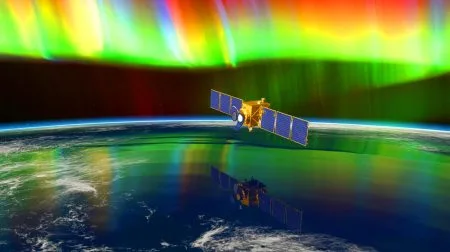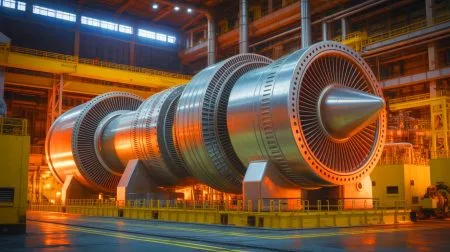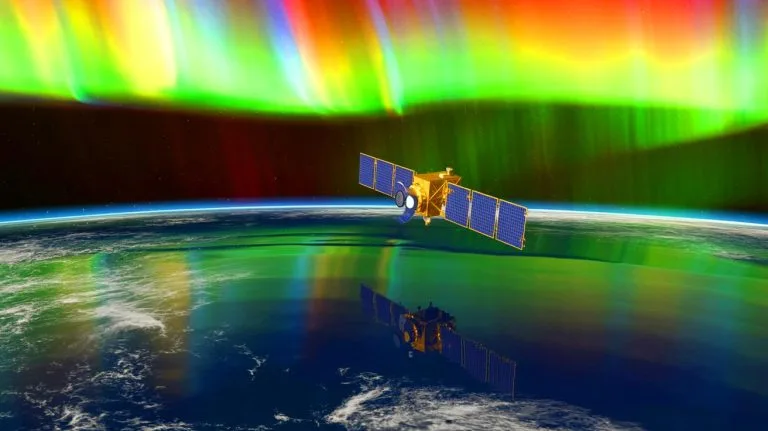| IN A NUTSHELL |
|
The South Atlantic Anomaly (SAA) is an area of scientific fascination and concern. This region, characterized by a weakened magnetic field over South America and the South Atlantic Ocean, presents a unique challenge for space technology. The anomaly’s impact on satellites and other space instruments has made it a focal point for NASA and other research institutions. As the SAA evolves, understanding its origins and implications becomes crucial for safeguarding our technological infrastructure. This phenomenon not only highlights the complexities of Earth’s magnetic field but also underscores the need for continuous monitoring and research to anticipate future challenges.
Deep Origins and Complex Mechanisms
The South Atlantic Anomaly, with its reduced magnetic intensity, is more than just a scientific curiosity. It represents a breach in Earth’s protective magnetic shield, allowing high-energy solar particles to approach more closely than usual. The origins of the SAA are linked to the geodynamo, a process occurring in Earth’s outer core where the movement of molten iron and nickel generates the planet’s magnetic field. However, this generation is uneven.
Two main factors contribute to the SAA’s formation: the tilt of Earth’s magnetic axis relative to its rotational axis, and the influence of the African Large Low Shear Velocity Province, a dense structure located about 1,800 miles beneath the African continent. These factors disrupt standard magnetic field generation, causing a local polarity reversal. This results in a weakened magnetic intensity in the SAA region, posing risks to space technology that must be addressed.
A Threat to Space Technology
The magnetic weakness of the SAA presents significant risks to satellites and space technology. As satellites pass through this region, they encounter high levels of energetic protons, leading to potential single event upsets (SEUs). These events can cause temporary malfunctions, data corruption, or even permanent damage to critical systems.
Satellite operators often mitigate these risks by shutting down non-essential systems while traversing the SAA. Even the International Space Station (ISS) passes through the anomaly on each orbit. Although its shielding offers protection to astronauts, external instruments remain vulnerable. Bryan Blair, deputy principal investigator for the GEDI instrument on the ISS, reports occasional glitches and resets, resulting in data loss. Other missions, like the Ionospheric Connection Explorer (ICON), also monitor the SAA closely, adjusting operations to minimize disruptions.
Dynamic Evolution and Challenges
The South Atlantic Anomaly is not static; it evolves dynamically over time. Recent data from the European Space Agency’s Swarm constellation and NASA’s historical SAMPEX mission measurements highlight several concerning trends. The anomaly is drifting northwest, expanding, and since 2020, it has begun to split into two distinct lobes. This bifurcation creates two centers of minimum magnetic intensity.
This development increases the number of hazardous zones for spacecraft and complicates efforts to model geomagnetic conditions accurately. Understanding the SAA’s changing morphology is essential for the safety of current and future satellites. As Terry Sabaka of NASA emphasizes, these changes necessitate continuous monitoring and adaptation in satellite operations to mitigate potential disruptions and ensure the safety of space missions.
Anticipating the Invisible
NASA employs a combination of satellite data and simulations of Earth’s core dynamics to refine understanding and predictions regarding the SAA. These inputs inform global models like the International Geomagnetic Reference Field (IGRF), which track Earth’s magnetic field evolution. These models are vital not only for planning space missions but also for enhancing knowledge of Earth’s internal structures.
While the current SAA evolution is unprecedented in the space era, geological records suggest such anomalies are not rare over extended periods. Scientists maintain that the current SAA is not an early indicator of a magnetic pole reversal, a natural event occurring over hundreds of thousands of years. Studying the SAA is crucial for protecting orbiting technologies and understanding the deep forces driving our planet’s dynamics.
As the South Atlantic Anomaly continues to evolve, the scientific community remains vigilant in its efforts to understand and mitigate its impact. With its potential to disrupt satellite operations and influence our understanding of Earth’s magnetic field, the SAA poses intriguing questions about the future of our planet’s magnetic dynamics. How will these changes shape our technological and scientific pursuits in the years to come?
Did you like it? 4.5/5 (20)







Is it true that the SAA can affect GPS signals too? 🤔
Wow, this is fascinating! Who knew the Earth’s core could be so dramatic? 😂
Great article! But why is this not more widely known? Seems important!
Does this mean my GPS might start acting up more often? 🤔
Does the South Atlantic Anomaly affect climate patterns in any way?
Great article! I had no idea about the South Atlantic Anomaly before reading this. Thanks for the insightful read!
I wonder if this anomaly could affect Earth’s wildlife migration patterns? 🐦
How does NASA plan to keep satellites safe from the two lobes of the SAA?
Is there a connection between the SAA and the Bermuda Triangle? 😆
Why is the South Atlantic Anomaly splitting into two lobes? Can it merge back?
Does this anomaly have any effects on human health or technology on the ground?
Thanks for the article! This is fascinating and a bit scary at the same time.